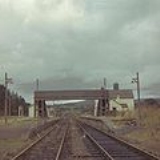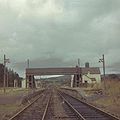
Lydford railway station
Encyclopedia

Lydford
Lydford, sometimes spelled Lidford, is a village, once an important town, in Devon situated north of Tavistock on the western fringe of Dartmoor in the West Devon district.-Description:The village has a population of 458....
between the Great Western Railway
Great Western Railway
The Great Western Railway was a British railway company that linked London with the south-west and west of England and most of Wales. It was founded in 1833, received its enabling Act of Parliament in 1835 and ran its first trains in 1838...
(GWR) and London and South Western Railway
London and South Western Railway
The London and South Western Railway was a railway company in England from 1838 to 1922. Its network extended from London to Plymouth via Salisbury and Exeter, with branches to Ilfracombe and Padstow and via Southampton to Bournemouth and Weymouth. It also had many routes connecting towns in...
(LSWR) situated in a remote part of north-west Dartmoor
Dartmoor
Dartmoor is an area of moorland in south Devon, England. Protected by National Park status, it covers .The granite upland dates from the Carboniferous period of geological history. The moorland is capped with many exposed granite hilltops known as tors, providing habitats for Dartmoor wildlife. The...
in Devon
Devon
Devon is a large county in southwestern England. The county is sometimes referred to as Devonshire, although the term is rarely used inside the county itself as the county has never been officially "shired", it often indicates a traditional or historical context.The county shares borders with...
, England
England
England is a country that is part of the United Kingdom. It shares land borders with Scotland to the north and Wales to the west; the Irish Sea is to the north west, the Celtic Sea to the south west, with the North Sea to the east and the English Channel to the south separating it from continental...
.
History
The station, known then as "Lidford", was opened on 1 June 1865 with the Launceston and South Devon Railway, a broad gaugeBroad gauge
Broad-gauge railways use a track gauge greater than the standard gauge of .- List :For list see: List of broad gauges, by gauge and country- History :...
line that connected with the South Devon and Tavistock Railway
South Devon and Tavistock Railway
The South Devon and Tavistock Railway was a broad gauge railway linking Plymouth with Tavistock in Devon, England. It opened in 1859, was extended by the Launceston and South Devon Railway to Launceston, Cornwall, in 1865, and was closed in 1962....
to offer a service to Plymouth Millbay railway station
Plymouth Millbay railway station
Plymouth Millbay railway station was the original railway terminus in Plymouth, Devon, England. It was used for passenger trains from 1849 to 1941.- History :...
. This line eventually became a part of the GWR.
On 12 October 1874 the LSWR line
West of England Main Line
The West of England Main Line is a British railway line that runs from , Hampshire to Exeter St Davids in Devon, England. Passenger services run between London Waterloo station and Exeter...
was opened from Okehampton railway station
Okehampton railway station
Okehampton railway station is a railway station serving the town of Okehampton in Devon, England. Heritage train services currently operate on certain weekdays, weekends and bank holidays...
. This was a standard gauge
Standard gauge
The standard gauge is a widely-used track gauge . Approximately 60% of the world's existing railway lines are built to this gauge...
line that carried trains direct from London Waterloo station, whereas passengers to the GWR's London Paddington station had to travel on the branch line to Plymouth and then change onto a main line train.
On 17 May 1876 a junction was opened between the two lines and LSWR trains could now reach its new station at Devonport
Devonport Kings Road railway station
Devonport Kings Road railway station was the London and South Western Railway station in Devonport, Devon, England. It opened in 1876 and closed in 1964...
by running over the GWR's route, which was now mixed gauge
Dual gauge
A dual-gauge or mixed-gauge railway has railway track that allows trains of different gauges to use the same track. Generally, a dual-gauge railway consists of three rails, rather than the standard two rails. The two outer rails give the wider gauge, while one of the outer rails and the inner rail...
. On 1 June 1890 a new line, built by the Plymouth, Devonport and South Western Junction Railway
Plymouth, Devonport and South Western Junction Railway
The Plymouth, Devonport and South Western Junction Railway in England was built by an independent company but operated by the London and South Western Railway as part of its main line to give it independent access to Plymouth. It ran from to Devonport Junction, just west of Plymouth North Road...
, gave the LSWR a route to Devonport independent of the GWR. The GWR line was converted to standard gauge on 20 May 1892.
The connection between the two lines was removed in 1895 but was replaced in 1943 to give flexibility should the railway lines around Plymouth be damaged by World War II
World War II
World War II, or the Second World War , was a global conflict lasting from 1939 to 1945, involving most of the world's nations—including all of the great powers—eventually forming two opposing military alliances: the Allies and the Axis...
bombing. Other connections were installed at Launceston railway station
Launceston railway station
Launceston railway station was situated in Launceston, Cornwall, United Kingdom. It was served by both the Great Western Railway and London and South Western Railway ....
and at St Budeaux.
The station had been renamed "Lydford" on 3 June 1897. Trains were withdrawn from the former GWR branch on 31 December 1962 but continued on the main line until 6 May 1968. Goods traffic ceased on 7 September 1964.
Description
The original station had a passing loop and two platforms, with the station offices on the platform used by trains towards Plymouth. The LSWR built their platforms alongside the original ones, so the original booking office became a waiting room on an island platform with both companies opening new offices on their respective outside platforms.From 1 March 1914 the LSWR took responsibility for the GWR platforms. The GWR signal box
Signal box
On a rail transport system, signalling control is the process by which control is exercised over train movements by way of railway signals and block systems to ensure that trains operate safely, over the correct route and to the proper timetable...
was closed on 8 January 1917, when signal controls were combined in a single box on the central platform with two lever frames – one for each line – placed back to back. The signalman had trains from Tavistock on his left when working the GWR frame, but on his right when working the LSWR one.
Goods traffic was handled in a yard at the north end of the station between the two lines with access from both.

